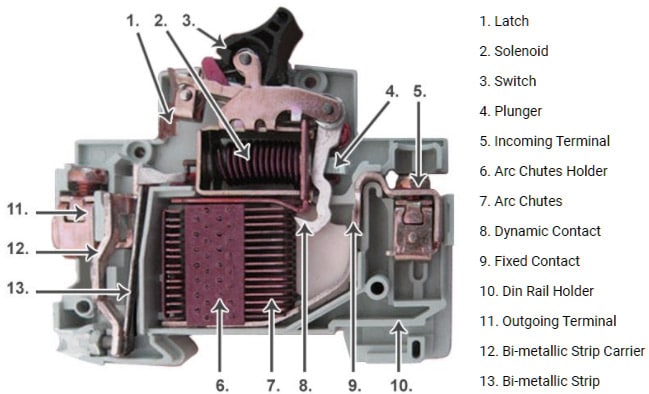Table of Contents
What happens to your household devices when there is a short circuit or overflow of current? The devices get burnt and lead to accidents. In order to avoid such mishaps, a circuit breaker is installed in electronic devices. Miniature Circuit Breaker is such a safety device that cuts off the current flow when there is an excessive flow of current in the circuit.
Start a Rewarding Career in MEP! Free Demo Classes Here!
Importance of Electrical Safety
Electricity is very powerful and at the same time it can be hazardous too. Overload, short-circuit, and earth faults can result in electrical accidents without any warning.
Hence electrical appliances need to be protected against fluctuations and overflow of current. In order to ensure safety, we should have the right systems in place. MCB is one such safety system which cuts off the flow of current when there is an excessive flow.
Role of MCB Boards in Modern Electrical Systems
The main role of MCB boards is to protect an electrical circuit from short circuit or overload. They are available in a variety of current ratings and have been successful in protecting against electrical hazards. Miniature circuit-breaker can also be used as an isolating switch or for local control switching.
Master MEP Design with Industry-Leading Training!
Gain in-depth knowledge of Mechanical, Electrical, and Plumbing (MEP) Design with expert-led courses. Learn HVAC, fire safety, sustainable building strategies, and BIM applications to excel in the construction industry.
Know MoreWhat is a Miniature Circuit Breaker (MCB)?
A miniature circuit breaker, also known as MCB, is an automatically operated electrical switch that switches off the electrical circuit during an abnormal condition such as overload or faulty condition of the network.
They are used to prevent damage to an electrical circuit caused by excess current. They trip during an overload or short circuit, thus protect the system against electrical faults and equipment failure.
Nowadays we use an MCB in a low-voltage electrical network instead of a fuse as it is more reliable and convenient. They are widely used in domestic, commercial, and industrial settings. Miniature circuit-breakers are available with current ratings from about 0.5 to 100 A, with a fault capacity of 16 kA.
Definition and Basic Functionality
The basic function of a miniature circuit-breaker is to protect an installation or appliance by interrupting the current flow in the circuit once a fault is detected. The fault can be caused by overloading and short-circuit. It also protects against earth faults if the earth fault loop impedance is low enough.
MCBs protect the system by breaking the contact of the circuit from supply if the supply current exceeds the rated current of MCB. This guarantees the reliability and safety for operations. MCB thus help protect the electrical devices connected to the circuit.
Components of an MCB Board
The components of an MCB are:
1. Latch
2. Solenoid
3. Switch
4. Plunger
5. Incoming Terminal
6. Arc Chutes Holder
7. Arc Chutes
8. Dynamic Contact
9. Fixed Contact
10. DIN Rail Holder
11. Outgoing Terminal
12. Bi-metallic Strip Carrier
13. Bi-metallic Strip
Description of Main Components
Air chutes: When there is a disruption of current flow in a circuit, an arc forms due to the ionization of air. The arc chute extinguishes this arc by creating a series of arc paths with increasing length. This helps in rapid cooling and deionization of the air.
Latch: The latch protects appliances or devices by turning off the MCB when there is an overflow of current. This stops the current flow in the circuit.
Plunger: During short circuit conditions, plunger associated with a tripping coil or solenoid is displaced. It then strikes the trip lever causing the immediate release of the latch mechanism thus opening the circuit breaker contacts.
Bi-metallic strip: It provides overload protection. When current overflows, the bi metallic strip gets heated and bends. This releases the latch, thus turning off the MCB.
Switch: This either connects or disconnects the conducting path in an electrical circuit.
Contacts: They carry the load current and are connected to the incoming and outgoing wires of the circuit.
Solenoid: A solenoid coil creates a magnetic field when current flows through it. This magnetic field pulls on a spring-loaded trip lever that releases the switch and causes the MCB to trip. This mechanism protects against short circuits.
Master MEP Design with Industry-Leading Training!
Gain in-depth knowledge of Mechanical, Electrical, and Plumbing (MEP) Design with expert-led courses. Learn HVAC, fire safety, sustainable building strategies, and BIM applications to excel in the construction industry.
Know MoreHow Does an MCB Work?
The MCB has two contact points, one connected to the incoming power supply and the other to the load. During normal operation, current flows through the MCB into the electrical circuit. If there is an overflow of current, the bi-metallic strip heats and bends and causes the latch to release.
This turns off the MCB and interrupts the flow of the current. The MCB must manually be turned on to restart the flow of current.
During short circuit, the current rises suddenly, causing electromechanical displacement of the plunger. The plunger strikes the trip lever and immediately releases the latch mechanism, thus breaking the circuit.
Start a Rewarding Career in MEP! Free Demo Classes Here!
Types of MCBs
Even though the different types of MCBs are – Type A, B, C, D, K, and Z, the three important ones are type B, C, and D. Each type refers to the different levels of protection provided.
Type A
These MCBs provide protection against over-current. They are suitable for use in circuits like lighting circuits where the maximum expected current is known and relatively constant.
Type B
Type B MCBs are the most sensitive ones. They provide protection if the current flowing through it is between three and five times the recommended load. They are suitable for use in circuits where the load is variable, such as in motor circuits.
Type C
These MCBs provide protection against both over-current and earth fault currents. They are used in commercial and industrial environments where surges are likely to be higher. They provide protection if the current flowing through it is between five and ten times the recommended load.
Type D
They are suitable for circuits where there is a high risk of earth fault currents, and the fault current is higher than what can be protected by Type C MCBs. They get activated when current surges between ten and twenty times the recommended load.
Type D MCBs are used in heavy-duty commercial and industrial devices such as X-ray machines, welding equipment, etc.
Type K
These MCBs break the circuit when the current reaches eight to twelve times the recommended maximum. They are used in motors and electrical systems with high fault levels.
Installation and Configuration
- Choose the right MCB that matches the load
- Prepare the Distribution Board (DB) and choose an appropriate location to install the new MCB.
- Connect the MCB
- Test the functionality
- Label and record for future identification
Advantages of Using MCBs
- MCBs are available in several configurations with low voltage (LV) and high voltage (HV) ratings. They can be used in a wide range of applications.
- They are available in different sizes and shapes and can be easily integrated into existing systems and installations.
- They are easy to install, use, and are highly effective at preventing electrical failures and potential fires.
- A fuse needs to be replaced if a circuit breaks, but MCBs can be reused by switching them on manually.
- MCBS are relatively safer.
Smart MCBs
Smart MCBs are enhanced version of MCBs that can quickly detect any abnormalities in the electric current and provide optimum security in domestic and industrial environments. These MCBs have contact indicators that ensure effective monitoring thus allowing users to easily identify the status of the circuit.
They are available in 1P+N compact modules and help save valuable space in installations where panel space is limited. They can also be customized according to requirements.
The breaking capacity of smart MBCs are up to 6kA which makes them highly effective in protecting circuits and preventing potential damage.
Integration with IoT and Home Automation
IoT based MCBs use the Internet to control electrical loads. They provide real time data analysis and have a high response time.
These MCBs provide intelligent and automated protection against electrical hazards. They also improve electrical safety and improve efficiency.
Start a Rewarding Career in MEP! Free Demo Classes Here!
Master MEP Design with Industry-Leading Training!
Gain in-depth knowledge of Mechanical, Electrical, and Plumbing (MEP) Design with expert-led courses. Learn HVAC, fire safety, sustainable building strategies, and BIM applications to excel in the construction industry.
Know MoreFrequently Asked Questions
How does an MCB work?
If the current flowing through an electrical circuit exceeds the maximum level set for the MCB, it will trip and interrupt the circuit.
What is the standard current rating for MCBs?
The common ratings of MCBs are 1A, 2A, 5A, 10A, 16A, 20A, 25A, 32A, 40A, 50A, and 63A.
What is the difference between an MCB and a fuse?
Even though the function of both fuse and MCB is to protect a circuit, there is a significant difference between them. A fuse melts and disconnects the circuit if the current becomes too high, whereas an MCB can be reset after it trips and continues to provide protection.












